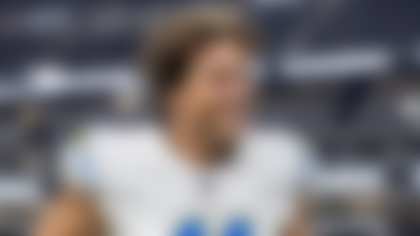As we approach the annual tea leaf reading and analytics-crunching ritual of searching for a franchise quarterback in the NFL draft, it's worth remembering: The past is prologue.
The 2018 quarterback-rich class was hyped and compared to the boom QB drafts of 1983 (Dan Marino, John Elway, Jim Kelly, Ken O'Brien) and 2004 (Ben Roethlisberger, Philip Rivers, Eli Manning), leaving no shortage of pre-draft accolades for the '18 class:
*"NFL teams needing help at quarterback will have no excuses this year with a crop of talent worthy of comparison to even the renowned Class of 1983 ..." -- NFLDraftScout.com *
*"Quarterbacks are going to dominate the conversation surrounding the 2018 NFL Draft. It's possible five signal-callers could get selected ..." -- Bleacher Report *
"The numbers this year will show that this is a quarterback-rich draft class ..." -- Sports Illustrated
OK, so how did the 2018 class do as rookies? Well, suffice to say it's too early to anoint anyone "franchise," but there's lots to learn for scouts, GMs and coaches looking for their own miracle in 2019.
In fact, five quarterbacks were taken in the first round in 2018: Baker Mayfield (No. 1 overall, Browns), Sam Darnold (No. 3, Jets), Josh Allen (No. 7, Bills), Josh Rosen (No. 10, Cardinals) and Lamar Jackson (No. 32, Ravens). All were supposedly going to sit, at least for some period of time, behind veterans to learn. But in the NFL today, with owner pressure, coach pressure, fan pressure and pressure to win, that rarely happens. And it didn't this year. Instant gratification and impatience rule, and all five rookies became starters.
As for their performances, one might make the observation of my mentor and coach, Dennis Green: "They are who we thought they were." What we saw in their college years largely played out in their first NFL seasons. What they were good at then, they're good at now. What were shortcomings didn't suddenly get fixed. With the exception of Mayfield, the group had very rookie-like numbers -- completing less than 60% of pass attempts and a 1:1 touchdown-to-interception ratio, or sometimes worse.
Don't expect a miracle first season with new QB
The worst teams get the best picks. That's the way it works. Losing records are rewarded with high picks. It's the NFL's attempt at maintaining parity among the teams ... if those losing teams are good at making draft picks. But teams that have weak finishes almost always have weaknesses at a variety of positions -- offense and/or defense -- and are rarely otherwise good teams just waiting for a great quarterback. So no matter how well they draft, rationally we shouldn't expect a miracle year. But owners, commentators and (mostly) fans do. Being rational has nothing to do with it.
No wonder Baker Mayfield sat behind Tyrod Taylor for all of two games. He entered Week 3's contest against the Jets after Taylor got hurt, with the Browns trailing 14-0. Mayfield led a comeback to win the game 21-17 and more significantly, mercifully, bring an end to the Browns' ignominious 19-game winless streak. In Week 4, Mayfield took over as the starter, the team's 30th starter since 1999, the year they came back to the NFL, another ugly distinction. The rookie began to turn around a team that hasn't seen hope in a long time (but not without casualties -- more on that later). Mayfield seemed to finally be the right guy, breaking Peyton Manning and Russell Wilson's previous record for rookie TD passes at 27 and leading Cleveland to a season record of 7-8. It wasn't the Super Bowl, but it was a start.
Sam Darnold, despite concerns about his up-and-down college performance, had draft experts pointing to his two seasons at USC (64.9 completion percentage and 57:22 TD-to-INT ratio) and putting him head-to-head with Mayfield as the top pick. Taken at No. 3 overall by the Jets, Darnold was the second quarterback taken in the draft. He then beat out Teddy Bridgewater and Josh McCown and was named the starter before the season even began. Darnold started all but three games, missing time with a foot injury but went right back in the moment he was healthy. The Jets were committed to their rookie. In 13 starts, he completed only 57 percent of pass attempts and his TD-to-INT ratio was way too close at 17:15. In fact, his first-ever NFL throw was a pick against the Lions, but the Jets did win the game. (Unfortunately, it was only one of four wins against 12 losses for the team.) Do we blame: a) Darnold; b) the team around him; or c) the coaching ... or all three? The offseason and next season may tell.
Josh Allen, taken seventh overall by the Buffalo Bills, came out of Wyoming with eye-popping physical skills, a completion percentage of less than 60 and a 2:1 TD-INT ratio, the last two worrisome omens. The Bills didn't start Allen in the opener, instead going with journeyman Nathan Peterman who was blown out of the game by the Ravens, 47-3. Then Allen was put in too late to do anything except show that he was now the starter. Allen started 11 games for the Bills where they went 5-6, only having completed 52 percent of his passes and throwing 10 touchdowns to 12 interceptions -- ouch, the omens came true! He had one good game, beating the Vikings with good passing and 39 yards on the ground. He was injured a few weeks later (elbow) and missed part of the season. He came back as the starter -- another team betting on their young hope -- but the team's fate didn't change much as Buffalo finished at 6-10.
The Arizona Cardinals went with Josh Rosen with the 10th overall pick. Rosen's career at UCLA had some spectacular and promising numbers, but he went through multiple coordinators and systems and there was always mumbling about his "maturity." After starter Sam Bradford (by the way, a No. 1 overall pick himself) suffered two lopsided losses and was in the midst of third, Rosen came in Week 3 and was the starter from then on -- so much for sitting behind the veteran. The team went 3-10 under Rosen, who completed just 55 percent of his passes and had 11 TDs to 14 INTs. Was that Rosen's immaturity, other team weaknesses, coaching problems and changes, or all of the above? Again, Year 2 may tell.
The Baltimore Ravens surprised a lot of experts by trading up to take a quarterback, grabbing Lamar Jackson with the 32nd pick. Of all the first-round QBs, he may be the most interesting. The Heisman Trophy winner had a solid career at Louisville with 69 TDs to 27 lNTs, but like Allen, had a completion percentage under 60 (vs. Baker Mayfield with a completion percentage of 68.5 and 119 TDs to 21 INTs). After what looked like a strong start, franchise QB Joe Flacco ran into hip trouble and eventually had to be sidelined. When Jackson took over, the Ravens were mired in a three-game losing streak. Jackson went on a 6-1 run -- yes, "run" is the right word -- averaging 20 carries a game for 695 yards and five TDs. As many a defensive coordinator put it, "With his run threat, you had to cover 11 players, not just 10." Though his passing number were dubious with a completion percentage of less than 60 and six TDs to three INTs. After a surprise win over the Chargers and holding off the energized Browns (rookie vs. rookie), Jackson propelled the Ravens, at 10-6, into the playoffs for the first time in four years. Then it seems the defense figured him out and those same Chargers beat the Ravens in the playoffs. Was the team now committed to Lamar Jackson? They traded their "franchise" Super Bowl quarterback and sent Flacco to the Broncos, so that's a pretty clear answer.
WARNING: Rookie QBs may be hazardous to a coach's future
As the next wave of teams in need of a quarterback head into the draft, a caution: That owner, fan, win-now impatience doesn't bode well for coaches. Losing, even for a team riddled with weak spots, has to be somebody's fault, and it can't be on the first-round rookie a team just landed, at least not yet. So it must be the coaches, right? Well, not right, or fair, but it is what often happens. Look at last season and the coaches' corpses strewn over the fields.
From the moment the Browns drafted Mayfield, there were rumors of discord in the management/coaching ranks. The Browns had their usual rocky start: Tyrod Taylor struggled and Mayfield inherited a team not used to winning. There had to be a scapegoat, or two. After Week 8, head coach Hue Jackson and offensive coordinator Todd Haley were fired. Freddie Kitchens, then the running backs coach, took over as the interim and was named head coach at the end of the season. Was Mayfield the cause of Jackson and Haley's demise? Well, suffice to say there was no love lost. Jackson was then hired by the Bengals in mid-season, and Mayfield went out of his way to get in the face of his ex-coach on the sidelines during a division matchup. Schoolyard stuff.
How about the Jets coaching staff? There was no disagreement in their camp on drafting Darnold. Todd Bowles was all in as much as the GM or the owner, but the Jets kept losing. So, Bowles was shown the door after four seasons, and admittedly an awful record. The Jets then brought in Adam Gase, considered a "quarterback whisperer" based on his work with Peyton Manning in Denver and Jay Cutler in Chicago. Gase had been hired by the Dolphins to do likewise with Ryan Tannehill, but after three seasons -- one good, two not so good -- was fired. But it's no coincidence that with the Jets betting on a rookie quarterback, they traded in Bowles, a defensive-minded head coach, for an offensive and quarterback guy, Gase, who then hired his former colleague from Miami, Dowell Loggains as the OC/quarterback coach. We'll see ...
Between Weeks 7 and 8, coming off another loss, Cardinals offensive coordinator Mike McCoy was fired and replaced by quarterbacks coach Byron Leftwich. After only one season as Arizona head coach, Steve Wilks was fired. Not only were both coaching casualties of the win-now lust, but for Rosen, who had a merry-go-round of coaches at UCLA, it now means getting used to a new offensive coordinator, a new head coach and another new system. Or worse. The question isn't just whether he'll click with new coach Kliff Kingsbury (fired by Texas Tech, hired by the Cardinals), but whether he'll even be in Arizona to play under Kingsbury. Only a few weeks into the job, reporters were reminding Kingsbury of his earlier lavish praise of Kyler Murray, the highly-touted quarterback coming out of Oklahoma. Kingsbury had conjectured, if he were an NFL head coach and had the top pick, he'd take Murray. Well, he is a head coach and he does have a top pick, and as recently as April 11, Murray visited the Cardinals camp and made quite an impression. Rosen is worth plenty as trade bait, so what might be good for Kingsbury could be bad for Rosen. Or good for Rosen depending on where the wheel stops spinning.
Despite years of Ravens coach John Harbaugh standing staunchly behind Flacco, Harbaugh saw the future and went all in on Lamar Jackson. Then, defying chatter to the contrary, Harbaugh was signed to a long-term extension, but that didn't mean there was no coaching bloodshed. Offensive coordinator Marty Mornhinweg was replaced by receivers coach Greg Roman. Again, no coincidence that with all the chips on a new quarterback, the OC job went to a quarterback guy.
In fact, the only team that took a first-round quarterback and didn't make a major coaching change was the Bills. Second-year head coach Sean McDermott and first-year offensive coordinator Brian Daboll were retained. The Bills had a forgettable season. Josh Allen had rookie troubles. But they kept the coaching staff ... for now. How long will the owner and GM wait? How much will the loyal Buffalo fans take? How patient will they be? Let's put it this way: If I were a coach in Buffalo, I might be better off renting a home instead of buying one, at least for another year.
That was the past -- here's the prologue
What can the 2018 quarterback class tell us about the 2019 class? What does it mean for the prospects and the teams shopping for quarterbacks?
There are five or six strong prospects who could shake out to two or even three taken in the first round (and maybe a couple others later): Oklahoma's Kyler Murray (great numbers, size an issue, just chose the NFL over MLB), Ohio State's Dwayne Haskins (50 TDs to just eight INTs, but few starts), Duke's Daniel Jones (coached by David Cutcliffe who coached Peyton Manning among others), Missouri's Drew Lock (sometimes great, sometimes not, and some trash talk), West Virginia's Will Grier (had a PED suspension at Florida, transferred to West Virginia and hit for 71 TDs).
Which teams are shopping? The Dolphins (moved on from Tannehill), Redskins (Alex Smith injury) and Giants (life after Eli Manning). And until they traded for Joe Flacco, probably the Broncos ... or are they still in the market? Those are the teams in need of a big turnaround fast. The odds are ... they won't get it. At least not fast. Franchise quarterbacks don't tend to emerge as rookies. Again, largely because they're playing for otherwise weak teams. That's why Year 2 or 3 for high draft picks tend to be better. Witness the Rams' Jared Goff, who got off to an 0-7 start his first year, then went to the playoffs his second year and the Super Bowl his third. Or the Chiefs' Patrick Mahomes, who rarely got in a game as a rookie but set the league on fire by Year 2 and was named league MVP.
It takes patience, the one thing the NFL and its fans are short on. Look at the talent-loaded quarterback group from 2018. They had seasons we could've predicted (but didn't want to). Now we'll really find out who's good and who may be great. So advice to those who draft a quarterback in 2019:
Don't expect an overnight miracle. And if the past is really prologue, no one will follow that advice. It's the NFL.
Brian Billick, Super Bowl Coach and NFL commentator/analyst, and co-author James Dale, are currently working on an upcoming book about quarterbacks, what separates good from great, the mysteries of the draft, and maybe how to draft better.












